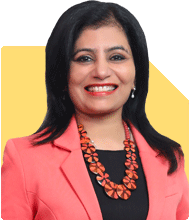Ramalingam Kalirajan |9758 Answers |Ask -Follow
Mutual Funds, Financial Planning Expert - Answered on Jun 06, 2024
He has an MBA in finance from the University of Madras and is a certified financial planner.
He is the director and chief financial planner at Holistic Investment, a Chennai-based firm that offers financial planning and wealth management advice.... more

Me and my husband are 28 years old. We are earning a monthly income of Rs. 120000/- and can save upto Rs. 30000/- for the purpose of buying a house. We are not buying house immediately. We thought of saving money through investments and then buy a house 10 years from now. Can you please suggest investment plans for us so that we can buy a house 10 years from now? We thought of saving 90 lakhs to 1 crore for the purpose of buying the house.
Planning to buy a house in 10 years is a smart and ambitious goal. You and your husband have a stable income and are able to save Rs 30,000 per month. With proper investment strategies, you can accumulate the desired amount of Rs 90 lakhs to 1 crore. This guide will help you understand how to invest wisely and achieve your goal.
Understanding Your Financial Situation
Monthly Income and Savings
You both earn a combined monthly income of Rs 1,20,000. Out of this, you can save Rs 30,000 each month. This is a substantial amount that can be effectively invested to reach your target.
Financial Goals
Your primary goal is to save Rs 90 lakhs to 1 crore in 10 years for buying a house. Setting clear and specific financial goals helps in planning the investment strategy.
Investment Strategies for Long-term Goals
Importance of Starting Early
Starting your investments early gives you the advantage of compounding. Compounding is the process where the returns on your investments start generating their own returns. Over 10 years, this can significantly increase your savings.
Risk Tolerance and Investment Choices
At 28 years old, you have a higher risk tolerance compared to older investors. This allows you to invest in higher-risk, higher-return options. However, it’s essential to balance this with some stable, lower-risk investments to protect your capital.
Types of Investment Options
Equity Mutual Funds
Equity mutual funds invest primarily in stocks. These funds have the potential to provide high returns over the long term. Given your 10-year horizon, equity funds can be a major component of your investment portfolio.
Hybrid Mutual Funds
Hybrid funds invest in a mix of equities and debt instruments. They offer a balanced approach, providing growth potential while mitigating some risks associated with equities. These funds are suitable for investors seeking moderate risk and returns.
Debt Mutual Funds
Debt funds invest in fixed income securities like bonds and treasury bills. They are less volatile than equity funds and provide steady returns. Including debt funds in your portfolio can add stability and reduce overall risk.
Systematic Investment Plan (SIP)
A SIP allows you to invest a fixed amount regularly in mutual funds. It helps in averaging out the purchase cost and instills disciplined investing. SIPs are particularly beneficial for long-term goals like buying a house.
Detailed Investment Plan
Step-by-Step Investment Plan
Assess Your Current Savings and Investments:
Evaluate any existing savings and investments you have.
Include them in your plan to have a clear picture of your starting point.
Set Up a SIP:
Allocate a portion of your monthly savings (Rs 30,000) to SIPs in equity mutual funds.
For instance, you could invest Rs 20,000 in equity funds and Rs 10,000 in hybrid or debt funds.
Diversify Your Portfolio:
Diversify your investments across different types of funds and sectors.
This strategy reduces risk and increases potential returns.
Monitor and Review Regularly:
Review your portfolio at least once a year.
Ensure it aligns with your financial goals and risk tolerance.
Make adjustments if needed, such as rebalancing your portfolio.
Estimating Future Value of Investments
Power of Compounding
Assuming an average annual return of 12% from equity mutual funds, let's calculate the future value of your investments.
Monthly investment: Rs 30,000
Investment period: 10 years
Expected annual return: 12%
Using the SIP formula for future value,
Calculating this gives us a substantial amount, close to your goal of Rs 90 lakhs to 1 crore.
Importance of Regular Monitoring and Rebalancing
Regular Reviews
Regularly reviewing your portfolio ensures that it remains aligned with your financial goals. Market conditions change, and your portfolio may need adjustments to stay on track.
Rebalancing
Rebalancing involves adjusting your investments to maintain the desired asset allocation. For instance, if equities perform exceptionally well, they may constitute a larger portion of your portfolio than intended. Rebalancing helps maintain the risk-return balance.
Tax Implications and Benefits
Long-term Capital Gains Tax
Long-term capital gains (LTCG) from equity mutual funds (held for more than one year) are taxed at 10% if they exceed Rs 1 lakh in a financial year. Short-term capital gains (STCG) are taxed at 15%.
Tax-saving Investments
Consider investing in Equity Linked Savings Schemes (ELSS) which offer tax benefits under Section 80C of the Income Tax Act. These funds have a lock-in period of three years and can provide good returns along with tax savings.
Building a Robust Financial Plan
Emergency Fund
Set aside 3-6 months of expenses in a liquid fund or savings account. This fund acts as a financial cushion during emergencies, ensuring you don’t have to dip into your investments.
Insurance
Ensure you have adequate health and life insurance. These policies protect you and your family from unforeseen events and provide financial security.
Retirement Planning
Even while saving for a house, don’t neglect retirement planning. Investing in equity mutual funds for retirement can help build a substantial corpus over time.
Consulting with a Certified Financial Planner (CFP) or Mutual Fund Distributor (MFD)
Professional Guidance
While this guide provides a comprehensive plan, consulting with a Certified Financial Planner or a Mutual Fund Distributor can provide personalized guidance. They can help tailor the investment plan to your specific needs and goals, ensuring optimal asset allocation and risk management.
Importance of Professional Advice
Professional advice ensures that you are making informed decisions and staying on track to achieve your financial goals. A CFP or MFD can help you navigate the complexities of investing and offer valuable insights.
Conclusion
Investing in mutual funds is a smart way to save for your house purchase in 10 years. With a combined monthly income of Rs 1,20,000 and monthly savings of Rs 30,000, you are in a good position to achieve your goal. Understanding the types of mutual funds, assessing your financial goals, and choosing the right funds are crucial steps. Regularly review and rebalance your portfolio to stay on track.
Remember, investing is a journey that requires patience and discipline. Consulting with a Certified Financial Planner or a Mutual Fund Distributor can provide personalized guidance and ensure your investments are well-aligned with your goals. Stay focused, and you will be well on your way to buying your dream house.
Best Regards,
K. Ramalingam, MBA, CFP,
Chief Financial Planner,
www.holisticinvestment.in
You may like to see similar questions and answers below
Ramalingam Kalirajan |9758 Answers |Ask -Follow
Mutual Funds, Financial Planning Expert - Answered on May 05, 2024
Ramalingam Kalirajan |9758 Answers |Ask -Follow
Mutual Funds, Financial Planning Expert - Answered on May 15, 2024
Ramalingam Kalirajan |9758 Answers |Ask -Follow
Mutual Funds, Financial Planning Expert - Answered on Jul 14, 2024
Ramalingam Kalirajan |9758 Answers |Ask -Follow
Mutual Funds, Financial Planning Expert - Answered on May 23, 2025
Sunil Lala |214 Answers |Ask -Follow
Financial Planner - Answered on Jul 17, 2025
Sunil Lala |214 Answers |Ask -Follow
Financial Planner - Answered on Jul 17, 2025
Archana Deshpande |117 Answers |Ask -Follow
Image Coach, Soft Skills Trainer - Answered on Jul 17, 2025
Dr Nagarajan J S K |1829 Answers |Ask -Follow
NEET, Medical, Pharmacy Careers - Answered on Jul 17, 2025
Dr Nagarajan J S K |1829 Answers |Ask -Follow
NEET, Medical, Pharmacy Careers - Answered on Jul 17, 2025
Dr Nagarajan J S K |1829 Answers |Ask -Follow
NEET, Medical, Pharmacy Careers - Answered on Jul 17, 2025
Dr Nagarajan J S K |1829 Answers |Ask -Follow
NEET, Medical, Pharmacy Careers - Answered on Jul 17, 2025
Dr Nagarajan J S K |1829 Answers |Ask -Follow
NEET, Medical, Pharmacy Careers - Answered on Jul 16, 2025
Dr Dipankar Dutta |1755 Answers |Ask -Follow
Tech Careers and Skill Development Expert - Answered on Jul 16, 2025
Nayagam P P |8925 Answers |Ask -Follow
Career Counsellor - Answered on Jul 16, 2025























